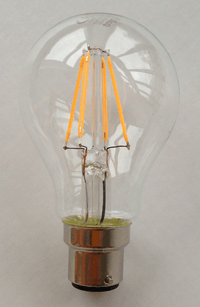LED filament

An LED filament light bulb is an LED lamp which is designed to resemble a traditional incandescent light bulb with visible filaments, for aesthetic and light distribution purposes. It produces its light by LED filaments, multi-diode structures that resemble the filament of an incandescent light bulb. They are designed as drop-in replacements for conventional clear incandescent bulbs used in decorative light fixtures, such as table lamps, pendant lights, chandeliers, and bulb-based candelabras. They have the appearance of traditional incandescent bulbs but the higher efficiency of light emitting diodes (LEDs).
History
A LED filament type design light bulb was produced by Ushio Lighting in 2008,[1] intended to mimic the appearance of a standard light bulb.[2] Contemporary bulbs typically used a single large LED or matrix of LEDs attached to one large heatsink. As a consequence, these bulbs typically produced only a 180 degree range of light.[2] By the mid 2010s, LED filaments were being introduced into the market by several manufacturers. These designs used several LED filament light producers arranged in the same or similar pattern to that found in the wires of standard incandescent bulb.[2]
LED filament bulbs were patented by Ushio and Sanyo in 2008.[1] Panasonic described a flat arrangement with modules similar to filaments in 2013.[3] Two other independent patent applications were filed in 2014 but were never granted.[4][5]
Design
The LED filament consists of multiple series-connected LEDs on a transparent substrate, referred to as Chip-On-Glass (COG). These transparent substrates are made of glass or sapphire materials. This transparency allows the emitted light to disperse evenly and uniformly without any interference. An even coating of yellow phosphor in a silicone resin binder material converts the blue light generated by the LEDs into white light.[2] Degradation of silicone binder, and leakage of blue light are design issues in LED filament lights. A market intelligence provider warns that LED filament lamp makers in China commonly use low-grade silicone to cut costs; it may become brittle after 200 hours of operation, causing the filament structure to fracture and break the LED string.[6]
Positive benefits of the LED design are potential higher efficiencies by the use of more LED emitters from lower driving currents. A major benefit of the design is the ease with which near full "global" illumination can be obtained from arrays of filaments.[2]

Lifespan of LED emitters is reduced by high operating temperatures. LED filament bulbs have many smaller, lower power LED chips than other types, avoiding the need for a heatsink, but they must still pay attention to thermal management; multiple heat dissipation paths are needed for reliable operation. The lamp may contain a high thermal conductivity gas (helium) blend to better conduct heat from the LED filament to the glass bulb.[2] The LED filaments can be arranged to optimise heat dissipation. The life expectancy of the LED chips correlates to the junction temperature (Tj); light output falls faster with time at higher junction temperatures (the "Droop Effect"). Achieving a 30,000 hour life expectancy while maintaining 90% luminous flux requires the junction temperature to be maintained below 85°C.[6]
The large number of LEDs (typically 28 per filament) simplifies the power supply compared to traditional LEDs as the voltage per blue LED is 2.48 < V < 3.7. Some types may additionally use red LEDs (1.63 < V < 2.03). Two filaments with a mix of red and blue is thus close to 110 V, or four close to 220 V to 240 V, compared to the 3 V to 12 V needed for a traditional LED lamp. Typically, four filaments are used and the appearance is similar to an overrun carbon filament lamp. Typically, a mix of phosphors are used to give a higher color rendering index (which is a separate issue from colour temperature) than the early blue LEDs with yellow only phosphor.
Gallery
 An LED filament bulb with an amber-colored glass shell and many filaments for better visual effects.
An LED filament bulb with an amber-colored glass shell and many filaments for better visual effects. Arranging filaments in a criss-cross pattern makes this 4-filament bulb look complex too.
Arranging filaments in a criss-cross pattern makes this 4-filament bulb look complex too. The same 4-filament bulb viewed from the top.
The same 4-filament bulb viewed from the top.
References
- 1 2 US 8400051, Kunihiko Hakata & Tomomi Matsuoka, "Light-emitting device and lighting apparatus incorporating same", published 2009-07-23, assigned to Ushio Denki KK
- 1 2 3 4 5 6 Lin, Judy (5 Feb 2015). "The Next Generation of LED Filament Bulbs". www.ledinside.com.
- ↑ Takeuchi, Nobuyoshi; Matsuda, Tsugihiro; Nagai, Hideo; Miki, Masahiro; Uemoto, Takaari (2014). "Light bulb shaped lamp and lighting apparatus". Retrieved 26 September 2017.
- ↑ Wu, Bor-jen. "LED LIGHT BULB (abandoned)". US Patent office. Retrieved 2015-01-04.
- ↑ Feng, Yunglong. "LED LIGHT AND FILAMENT THEREOF (abandoned)". US Patent office. Retrieved 2015-01-04.
- 1 2 "The Next Generation of LED Filament Bulbs". LEDinside. 5 February 2015. Retrieved 16 March 2018.
| Wikimedia Commons has media related to LED filament lamps. |